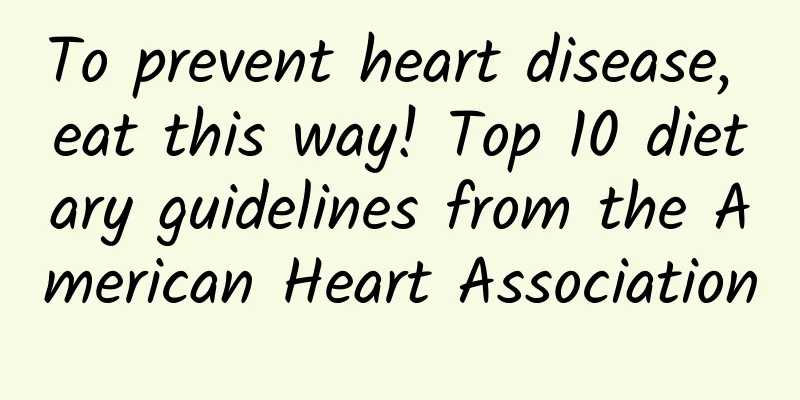To prevent heart disease, eat this way! Top 10 dietary guidelines from the American Heart Association

|
Recently, the American Heart Association published dietary guidelines for preventing heart disease, which emphasize the importance of paying attention to the overall dietary pattern rather than just emphasizing a certain food or nutrient. The guidelines show that no matter what stage of life, we can all benefit from a heart-healthy diet, and that it can be modified to suit personal preferences, lifestyle, and cultural norms. It doesn't have to be complicated, time-consuming, or expensive, or boring. In addition, whether you cook at home or order takeout, you can follow a healthy eating pattern, "and you can adapt a heart-healthy eating pattern to different lifestyles." Dietary patterns refer to the balance, variety, amount, and combination of food and beverages regularly consumed. The new guidelines point out that maintaining a healthy diet throughout life is beneficial to health, while low-quality diet increases the risk of cardiovascular disease and death. It also summarizes the ten characteristics of a diet that prevents heart disease: 1. Balance between eating and exercise: Exercise regularly to balance diet and calories and maintain a healthy weight; 2. Rich variety: Eat a rich diet, eat more vegetables and fruits, and get comprehensive nutrition from food instead of taking dietary supplements; 3. Eat less refined grains: Choose whole grains or foods made from whole grains; 4. High-quality protein: Include healthy lean meats and/or high-fiber proteins in your diet, such as plant protein (nuts and beans), fish and seafood, and low-fat or fat-free dairy products, and limit red meat and processed meat. 5. Healthy oils: Eat oils extracted from non-tropical plants such as olive oil or sunflower oil in moderation. 6. Fresh food: Choose minimally processed foods instead of ultra-processed foods whenever possible; Processed foods include meats that have been preserved by smoking, salting or adding preservatives, and plant foods that have added salt, sugar or fat. Ultra-processed foods are foods that have artificial colors, flavors and preservatives in addition to added salt, sweeteners or fat. 7. Eat less sweets: Try to eat less sugary drinks and foods; 8. Eat less salty food: Choose or prepare food with less or no salt; 9. Limit alcohol consumption: If you don’t have a habit of drinking, don’t start drinking; 10. Dietary Rules: No matter where you eat, you can follow this guideline. It also emphasizes the important role of health education, believing that healthy eating should be emphasized early in life and maintained throughout life. It also explores the social and other challenges that may exist in maintaining a heart-healthy eating pattern. For the first time, the guidelines also take into account the environmental sustainability of healthy food. Commonly consumed animal foods, especially red meat (beef, lamb, pork, veal, venison or goat), have the greatest environmental impact in terms of water and land use, and contribute significantly to greenhouse gas emissions. Therefore, shifting diets away from meat and toward plant-based proteins would also help improve the environment. The guidelines believe that promoting a heart-healthy diet is a win-win for individual health and environmental protection. Promoting healthy eating is not something that can be achieved overnight. There are many obstacles: false dietary information circulating on the Internet; lack of nutrition education in schools and medical schools; food and nutrition insecurity; inappropriate advertising; and dietary issues that are permeated with racism. "Creating an environment that promotes and supports everyone's adherence to heart-healthy dietary patterns is a public health priority," the guidelines state. Source: China Circulation Magazine |
>>: What harm has human beings brought to the ocean? What is deep in the ocean?
Recommend
What is the origin story of stinky tofu? Why does stinky tofu smell?
Stinky tofu is fried in oil, and the delicious ta...
"How Much Do You Know About Nutrition" Series | Is barley too hard to eat? Sprouting can make it more delicious and healthy
“Although highland barley has high nutritional va...
Eat seven kinds of food to prevent premature ovarian failure
Women should eat more of seven kinds of food to p...
Gynecological diseases are good there
For gynecological diseases, we must pay enough at...
What to do if you have back pain after cesarean section
Many mothers report that they experience back pai...
Postpartum breast lumps massage technique
Having a baby is not only one of the most importa...
Hormone response
In recent years, more and more women have paid gr...
Can I eat raw cucumbers during menstruation?
Luffa, can also be called cucumber. For many peop...
What is the cause of breast pain half a month before menstruation?
Breast problems are a concern for many female fri...
What causes women's stomach pain and back pain?
It is said that women are made of water, soft and...
Will pelvic effusion affect pregnancy?
Pelvic effusion is a problem that many pregnant m...
Caesarean section, phlegm in throat, dare not cough
If there is phlegm in the throat after a caesarea...
How to regulate low estrogen
Estrogen is a hormone produced by a woman's o...
How many days of pregnancy is best for medical abortion?
Medical abortion is a common abortion method. The...
How to treat oral ulcers in pregnant women
There are many oral diseases recorded in medicine...





![[Popular Science] How to relieve vomiting during pregnancy?](/upload/images/67f14ee2cf945.webp)



